- A study of 24 million real trades shows that performance can vary widely by time of trading day
- Many strategies fail because they ignore market conditions
- Using intraday seasonality could have an important impact on trading performance
Why do many traders fail at forex trading? Very often we find that common trading strategies have limitations that few understand. This article attempts to explain why some of the most popular currency trading techniques fail and, more importantly, how we might fix them.
Why might the Average Forex Trader Lose Money?
Experience and actual data shows that many forex traders do poorly for one of three key reasons.
- Poor money management techniques as discussed in our first article on Trader Performance
- Poor use of leverage combined with sub-par money management techniques as highlighted in our recent article.
- Poor market conditions for a given trader’s techniques and strategy. Many trading strategies do better in certain market conditions than others.
Our data on real client performance shows that traders on average do considerably worse during volatile market hours and through faster-moving markets. What does this look like and how might we look to improve on performance?
Looking at Real Trader Performance as a Start
We examine 24 million real trades placed across our 5 most popular currency pairs in the 12 months ending in Q1, 2015. If traders opened trades at a given hour of the trading day, what was the likelihood that they ultimately turned a profit?
Important note: trade winning percentage matters less than actual profitability Thus the chart below shows whether or not traders ultimately profited by trading a given currency pair at a specific hour of the day and not whether each individual trade was closed out at a profit.
Likelihood of Trader Profitability by Hour of Day in Top 5 Currency Pairs, Q2, 2014 – Q1, 2015
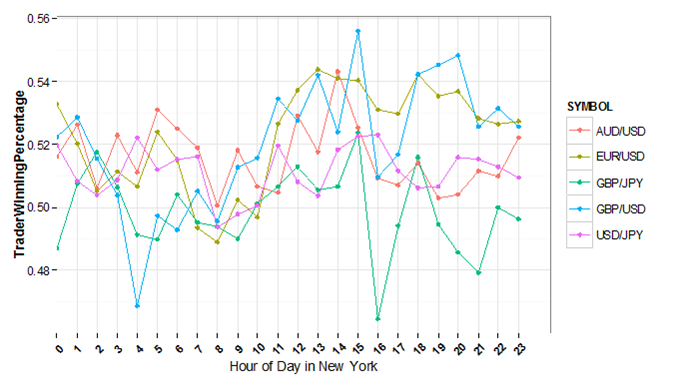
Data source: Derived from FXCM Inc. accounts excluding Eligible Contract Participants, Clearing Accounts, Money Managers, Hong Kong, and Japan subsidiaries from 4/1/2014 to 3/31/2015 across 15 most traded currency pairs.
There’s a lot going on in this chart but the pattern should be fairly clear: on average, traders saw considerably higher chances of ultimately turning a profit if a trade was opened in certain hours over others. Before we go more in-depth we’ll focus on the GBP/USD for further clarity and as a relevant example:
Likelihood of Trader Profitability by Hour of Day in GBP/USD, Q2, 2014 – Q1, 2015
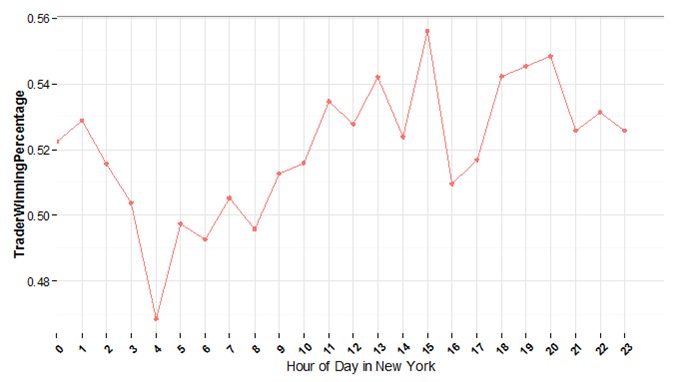
Data source: Derived from FXCM Inc. accounts excluding Eligible Contract Participants, Clearing Accounts, Money Managers, Hong Kong, and Japan subsidiaries from 3/1/2014 to 3/31/2015 across 15 most traded currency pairs.
If a trader opened British Pound/US Dollar trades between the hours of 04:00 and 05:00 New York Time, they ultimately turned a net-profit in the GBP/USD a mere 47 percent of the time. This stands in stark contrast with the opposite end—if a trade was opened between the hours of 20:00 and 21:00 (8:00 PM – 09:00 PM), traders ultimately turned a net-profit in GBP/USD trades 55 percent of the time.
Likelihood of overall success was nearly 20 percent higher in the later period. Why? Let’s take a look at how the British Pound behaves to better understand the major discrepancy.
Average Hourly Absolute Change in GBP/USD from 2005-2015
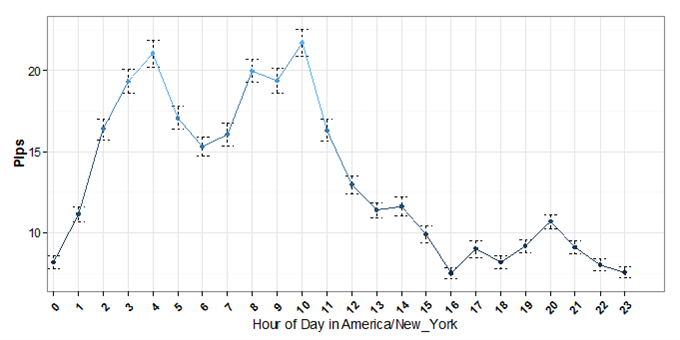
Data source: GBP/USD price data derived from FXCM’s price servers from 2005-2015.
Immediately we see that hour-to-hour changes in the GBP/USD vary significantly per different time of day. On average the Sterling moved 22 pips from 4am-5am New York time versus less than 4 pips between 23:00 – 00:00—over five times as volatile.
If we compare this against average trader profitability, we’ll further see that there’s a fairly clear negative relationship here: traders are least profitable when markets are most active. Traders tend to see the best results during the Asian trading session. To see why volatility lines up so well with performance, we need to look at real trader behavior.
Modeling Trader Behavior – Buying Low, Selling High
Our data on real trader behavior suggests that most traders tend to follow a somewhat straightforward strategy: Range Trading or Mean-Reversion trading. Put simply, such a technique is broadly defined as buying when prices are low/at support and selling when prices are high and/or at resistance.
Range Trading can work if price is not breaking major price levels and continues trading within relatively narrow ranges, and indeed this is typically the case during the quieter Asian Session hours. How might we match trading techniques to market conditions?
Does the Time of Day that I trade Matter?
Yes. It matters a lot. We have constructed a strategy that closely approximates the performance of the average trader, and we simulated that strategy’s performance on the GBP/USD. The results are not good.
Trade Rules for the RSI Trading Strategy
Buy Rule: When the 14-period RSI crosses above 30, buy.
Sell Rule: When RSI crosses below 70, sell.
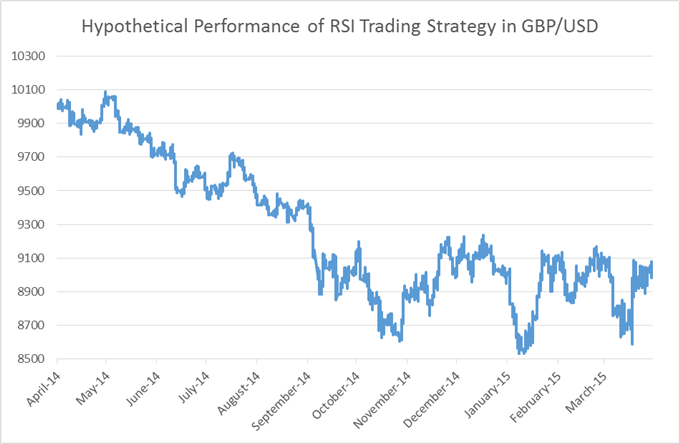
Data Source: FXCM Trading Station Desktop Strategy Backtester. GBP/USD 15-minute data from 4/1/2015-3/30/2015
Yet once we factor in the time of day, things become interesting. We know that the Sterling tends to move less through certain hours—let’s use that to our advantage and make a rule to trade only during low-volatility times.
This next chart shows the exact same strategy over the exact same time window, but the system does not open any trades during the most volatile time of day, 6 AM to 2 PM Eastern Time (11 AM to 7 PM London time).
Trade Rules for the RSI Asia Range Trading Strategy
Buy Rule: When the 14-period RSI crosses above 30, buy.
Sell Rule: When RSI crosses below 70, sell.
Trade Filter: Only allow the strategy to open trades before 06:00 and after 14:00 Eastern Time.
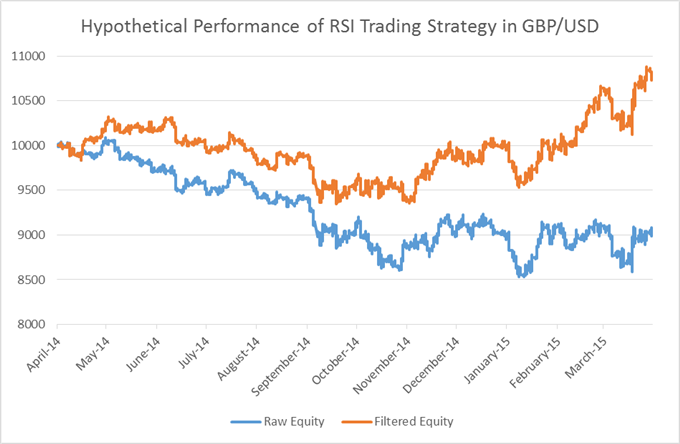
Data Source: FXCM Trading Station Desktop Strategy Backtester. GBP/USD 15-minute data from 4/1/2015-3/30/2015
By sticking to range trading only during the hours of 2pm to 6am, the typical trader would have hypothetically been far more successful over the sampled period.
What About Other Currency Pairs?
Of course not all currencies are the same. The Japanese Yen tends to see markedly more volatility than its European counterparts through the Asian trading session; these are the hours of the Japanese business day.
Average Hourly Absolute Change in JPY/USD from 2005-2015
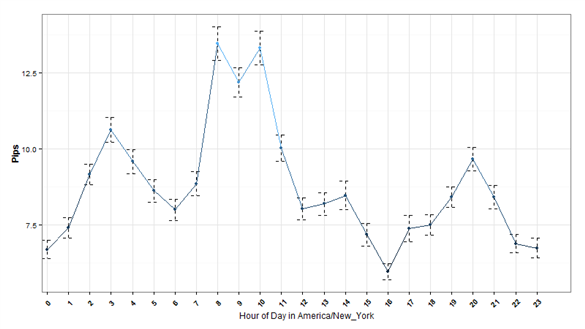
Data source: USD/JPY price data derived from FXCM’s price servers from 2005-2015.
We simulated the same filter as we used with the Euro/US Dollar. The poor results speak for themselves.
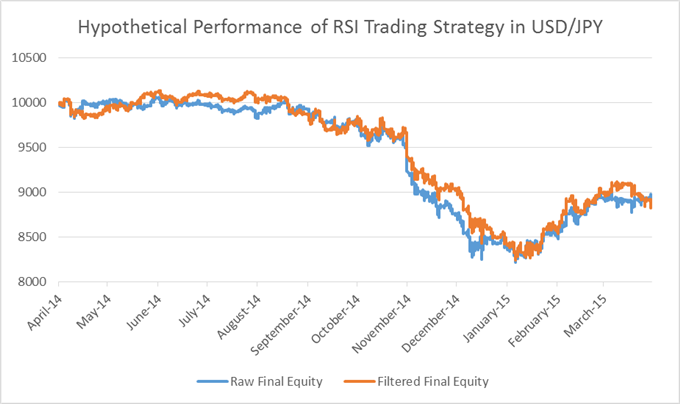
Data Source: FXCM Trading Station Desktop Strategy Backtester. USD/JPY 15-minute data from 4/1/2015-3/30/2015
We find that the time filters have historically worked well for European currency pairs such as the British Pound/US Dollar and the Euro/US Dollar. We might range trade these currency pairs during the 2 PM to 6AM time window.
Unfortunately, our optimal time window does not work well for Asian currencies. Our tests of different time windows on the USD/JPY, AUD/USD, and NZD/USD have not produced comparable improvements.
Game Plan: What Strategy May I Use?
Trade European currencies during the “Off Hours” using a range trading strategy.
Our data show that over the past 10 years, many individual currency traders have been successful range trading European currency pairs during the “off hours” of 2 PM to 6 AM Eastern Time (7 PM to 11 AM UK Time). Many traders have been very unsuccessful trading these currencies during the volatile 6 AM to 2 PM time period.
Asia-Pacific currencies can be difficult to range trade at any time of day as they tend to remain fairly active in what we would often consider ‘off-hours’ for most of the Western world.
Model Strategy: Range Trading with RSI on a 15 Minute Chart
For our models, we simulated a “typical trader” using one of the most common and simple intraday range trading strategies there is, following RSI on a 15 minute chart.
Editors’ Picks
EUR/USD rises toward 1.0700 after Germany PMI data

EUR/USD gains traction and rises toward 1.0700 in the early European session on Monday. HCOB Composite PMI in Germany improved to 50.5 in April from 47.7 in March, providing a boost to the Euro. Focus shifts Eurozone and US PMI readings.
GBP/USD eases below 1.2350, UK PMIs eyed

GBP/USD is dropping below 1.2350 in the European session, as the US Dollar sees fresh buying interest on tepid risk sentiment. The further downside in the pair could remain capped, as traders await the UK PMI reports for fresh trading impetus.
Gold price flirts with $2,300 amid receding safe-haven demand, reduced Fed rate cut bets

Gold price (XAU/USD) remains under heavy selling pressure for the second straight day on Tuesday and languishes near its lowest level in over two weeks, around the $2,300 mark heading into the European session.
PENDLE price soars 10% after Arthur Hayes’ optimism on Pendle derivative exchange

Pendle is among the top performers in the cryptocurrency market today, posting double-digit gains. Its peers in the altcoin space are not as forthcoming even as the market enjoys bullish sentiment inspired by Bitcoin price.
Focus on April PMIs today

In the euro area, focus today will be on the euro area PMIs for April. The previous months' PMIs have shown a return of the two-speed economy with the service sector in expansionary territory and manufacturing sector stuck in contraction.
RECOMMENDED LESSONS
Making money in forex is easy if you know how the bankers trade!
Discover how to make money in forex is easy if you know how the bankers trade!
5 Forex News Events You Need To Know
In the fast moving world of currency markets, it is extremely important for new traders to know the list of important forex news...
Top 10 Chart Patterns Every Trader Should Know
Chart patterns are one of the most effective trading tools for a trader. They are pure price-action, and form on the basis of underlying buying and...
7 Ways to Avoid Forex Scams
The forex industry is recently seeing more and more scams. Here are 7 ways to avoid losing your money in such scams: Forex scams are becoming frequent. Michael Greenberg reports on luxurious expenses, including a submarine bought from the money taken from forex traders. Here’s another report of a forex fraud. So, how can we avoid falling in such forex scams?
What Are the 10 Fatal Mistakes Traders Make
Trading is exciting. Trading is hard. Trading is extremely hard. Some say that it takes more than 10,000 hours to master. Others believe that trading is the way to quick riches. They might be both wrong. What is important to know that no matter how experienced you are, mistakes will be part of the trading process.
